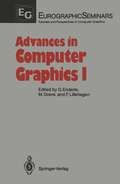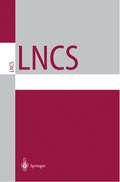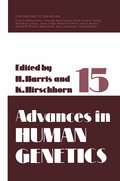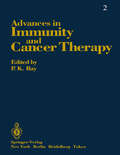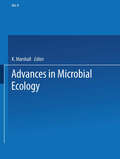- Table View
- List View
Advances in Chemical Physics (Advances in Chemical Physics #132)
by Stuart A. Rice Ilya PrigogineThe Advances in Chemical Physics series provides the chemical physics and physical chemistry fields with a forum for critical, authoritative evaluations of advances in every area of the discipline. Filled with cutting-edge research reported in a cohesive manner not found elsewhere in the literature, each volume of the Advances in Chemical Physics series serves as the perfect supplement to any advanced graduate class devoted to the study of chemical physics.
Advances in Chemical Physics (Advances in Chemical Physics #134)
by Stuart A. Rice Ilya PrigogineThe Advances in Chemical Physics series provides the chemical physics and physical chemistry fields with a forum for critical, authoritative evaluations of advances in every area of the discipline. Filled with cutting-edge research reported in a cohesive manner not found elsewhere in the literature, each volume of the Advances in Chemical Physics series serves as the perfect supplement to any advanced graduate class devoted to the study of chemical physics.
Advances in Chemical Reaction Dynamics (Nato Science Series C: #184)
by Peter M. Rentzepis Christos CapellosThis book contains the formal lectures and contributed papers presented at the NATO Advanced Study Institute on. the Advances in Chemical Reaction Dynamics. The meeting convened at the city of Iraklion, Crete, Greece on 25 August 1985 and continued to 7 September 1985. The material presented describes the fundamental and recent advances in experimental and theoretical aspects of, reaction dynamics. A large section is devoted to electronically excited states, ionic species, and free radicals, relevant to chemical sys tems. In addition recent advances in gas phase polymerization, formation of clusters, and energy release processes in energetic materials were presented. Selected papers deal with topics such as the dynamics of electric field effects in low polar solutions, high electric field perturbations and relaxation of dipole equilibria, correlation in picosecond/laser pulse scattering, and applications to fast reaction dynamics. Picosecond transient Raman spectroscopy which has been used for the elucidation of reaction dynamics and structural changes occurring during the course of ultrafast chemical reactions; propagation of turbulent flames and detonations in gaseous· energetic systems are also discussed in some detail. In addition a large portion of the program was devoted to current experimental and theoretical studies of the structure of the transition state as inferred from product state distributions; translational energy release in the photodissociation of aromatic molecules; intramolecu lar and intraionic dynamic processes.
Advances in Chromatography: Volume 25 (Advances In Chromatography Ser.)
by J. Calvin GiddingsThis book presents the most up-to-date information on a wide range of developments in chromatographic methods and applications. It provides timely, cutting-edge reviews in the fields of bio-, analytical, organic, polymer, and pharmaceutical chemistry.
Advances in Chromatography: Volume 25 (Advances In Chromatography Ser.)
by J. Calvin GiddingsThis book presents the most up-to-date information on a wide range of developments in chromatographic methods and applications. It provides timely, cutting-edge reviews in the fields of bio-, analytical, organic, polymer, and pharmaceutical chemistry.
Advances in Clinical Child Psychology: Volume 4 (Advances in Clinical Child Psychology #9)
by Alan E. Kazdin Benjamin B. LaheyAdvances in Clinical Child Psychology is a serial publication designed to bring together original summaries of the most important new develop ments in the field of clinical psychology and its related disciplines. Each chapter is written by a key figure in an innovative area of research or by an individual who is particularly well qualified to comment on a topic of major contemporary importance. These chapters provide convenient, concise explorations of empirical and clinical advances in the field. The chapter topics are chosen by the editors and are based on sug gestions by the advisory editors, unsolicited suggestions provided by colleagues, and from all of our reading of the latest published empirical and theoretical works. As such, it reflects our collective perception of the trends that are leading the field of clinical child psychology. Those trends are clearly evident in Volume 9. Two chapters describe the cur rent state of the art of intellectual and neuropsychological measurement. Two chapters discuss the classification and origins of the two types of attention deficit disorders. And one chapter focuses on the developmen tal importance of adolescence in child and family dysfunctions. But the overwhelming theme of this volume is the relationship between biolog ical and psychological variables. In choosing these chapters, we believe that we are merely reflecting the changing nature of research in the field.
Advances in Clinical Neuropsychology: Volume 3 (Advances in Clinical Neuropsychology #3)
by Gerald Goldstein Ralph E. TarterThis third volume of the Advances in Clinical Neuropsy chology series returns to the style of the first volume in that it contains contributions representing a diversity of areas. Within this diversity there are chapters covering specific disease entities of neuropsychological interest: cardiovascular diseases, Huntington's disease, head trauma in children, and hepatic encephalopathy. There are contributions in the area of neurobehavioral assessment; one involving the CT scan and the other the Luria-Ne braska Neuropsychologi cal Te st Ba ttery. Finally, there are several empirical reviews, including discussions of sex differences in brain function, the neuropsy chology of emotion, the relation between neuropsychological test results and patients' complaints of disability, and mechanisms of amnesia. Thus, this volume clearly continues the tradition established in previous volumes with regard to con~aining material that is both basic science and clinically oriented. The edi tors acknowledge the support of the Veterans Administration medical research program and the Department of Psychiatry of the University of Pittsburgh School of Medicine. We also appreciate the participation and effort of the chapter authors. And finally, we must again express our gratitude to Kathy Lou Edwards for her outstanding editorial, text compos iting, and administrative efforts. February:, 1986 Gerald Goldstein, Ph.D. Pittsburgh, Pennsylvania Ralph E. Tarter, Ph.D.
Advances in Cognitive—Behavioral Research and Therapy: Volume 5
by Philip C. KendallAdvances in Cognitive–Behavioral Research and Therapy, Volume 5 compiles assessment, treatment, and theoretical papers on cognition and behavior. This book discusses the asymmetry in the internal dialogue; reassessment of the empirical support for the rational-emotive model; and analysis of Beck's cognitive therapy for depression. The dysfunctional attitudes and a self-worth contingency model of depression; hot cognition and psychotherapy process; causal attributions in health and illness; and behavioral perspectives on the assessment and treatment of child abuse are also deliberated in this text. This publication is valuable to researchers and clinicians concerned with cognition and behavior.
Advances in Computer Assisted Learning: Selected Proceedings from the CAL 85 Symposium
by P. R. SmithAdvances in Computer Assisted Learning contains selected proceedings from the CAL Symposium on Computer Assisted Learning held at the University of Nottingham in the UK in 1985. This book reviews advances in computer-assisted learning in the areas of curriculum development, visually handicapped and disabled students, project work in schools, television, viewdata and video applications, database applications, and engineering education and training. This monograph has 35 chapters and opens with a discussion on the computing aspects of interactive video, focusing on the design and production of the software used to control the videodisc developed by the Open University in the UK. The next chapter illustrates a variety of case studies whereby local viewdata has been exploited by both teachers and their pupils in different parts of Europe. Attention then turns to the use of computer-assisted communication in the education of the visually impaired; the use of microcomputers in teaching electronics; and theoretical considerations in selecting software for language arts. This text will be of interest to educators and policymakers who want to implement computer technology in the classroom.
Advances in Computer Graphics I (Focus on Computer Graphics)
by Günter Enderle Michel Grave Frank LillehagenThis book is the sixth issue in the EurographicSeminars Series. This series has been set up by Eurographics, the European Association for Computer Graphics, in order to disseminate surveys and research results out of the field of Computer Graphics. Computer Graphics constitute a powerful and versatile tool for various application areas. The rapidly increasing use of Computer Graphics techniques and systems in many areas is caused by the availability of more powerful hardware at lower prices,' by the concise specification of Computer Graphics Interfaces in commonly·.agreed standards, and by the inven tion of new and often astonishing methods and algorithms for com position andpreserit~ti6n of pictJres and for graphical interaction. While s,o~e issues of this se.ries contain latest research results, e.g. the issues in window management systems or user interface manage ment systems, this book has the character of a state-of-the-art survey on important areas .of Computer Graphics. Starting from current practice and agreed consens, it will lead to the latest achievements in this field. The contributions in this issue are largely based on tutorials and seminars held at the Eurographics conferences 1984 in Copen hagen and 1985 in Nice.
Advances in Cryogenic Engineering: Volume 31 (Advances in Cryogenic Engineering #31)
by K. D. Timmerhaus R. W. Fast A. F. Clark R. P. ReedThe 1985 joint Cryogenic Engineering/International Cryogenic Materi als Conference was held on the campus of the Massachusetts Institute of Technology, Cambridge, Massachusetts. About 350 papers were presented at the joint conference on a wide variety of topics in cryogenic science and engineering. This volume of Advances in cryogenic Eogineerlng, the thirty-first in the series which began in 1954, contains most of the papers which were presented at the 1985 Cryogenic Engineering Conference. Each paper was rigorously peer reviewed to maintain the international reputation of Advances as the premier archival publication in the field of cryoscience, engineering, and technology. All the papers published in Volume 31 contain an abstract. A copy of the book will be sent to all maj or abstracting services, which should improve retrieval of the information contained in the published papers. I would like to thank the authors and those who served as reviewers. I especially appreciate the assistance of my colleague M. E. Stone who edited some of the papers for this volume. Terry Gutierrez was invaluable in preparing the manuscripts for publication, and I thank her. xvii DEDICATION Dr. Samuel C. Collins, Professor Emeritus of the Massachusetts Institute of Technology, internationally known as the father of practical helium liquefiers and founder of the MIT Cryogenic Engineering Laboratory, died on June 19, 1984, in George Washington University Hospital, Washington, DC.
Advances in Cryogenic Engineering Materials (Advances in Cryogenic Engineering #32)
by K. D. Timmerhaus R. W. Fast A. F. Clark R. P. ReedThe Sixth International Cryogenic Materials Conference (ICMC) was held on the campus of Massachusetts Institute of Technology in Cambridge in col laboration with the Cryogenic Engineering Conference (CEC) on August 12-16, 1985. The complementary program and the interdependence of these two dis ciplines foster the conference. Its manifest purpose is sharing the latest advances in low temperature materials science and technology. Equally im portant, areas of needed research are identified, prioriti-es for new research are set, and an increased appreciation of interdisciplinary, interlaboratory, and international cooperation ensues. The success of the conference is the result of the. able leadership and hard work of many people: S. Foner of M.I.T. coordinated ICMC efforts as its Conference Chairman. A. I. Braginski of Westinghouse R&D Center planned the program with the assistance of Cochairmen E. N. C. Dalder of Lawrence Livermore National Laboratory, T. P. Orlando of M.I.T., D. O. Welch of Brookhaven National Laboratory, and numerous other committee members. A. M. Dawson of M.I.T., Chairman of Local Arrangements, and G. M. Fitzgerald, Chairman of Special Events, skillfully managed the joint conference. The contributions of the CEC Board, and particularly its conference chairman, J. L. Smith, Jr. of M.I.T., to the organization of the joint conference are also gratefully acknm.ledged.
Advances in Cryptology: Proceedings of CRYPTO '85 (Lecture Notes in Computer Science #218)
by Hugh C. WilliamsA Conference on the Theory and Application of Cryptographic Techniques, Held at he University of California, Santa Barbara, through the Co-operation of the Computer Science Department, August 18 - 220, 1985
Advances in Cryptology – EUROCRYPT '85: Proceedings of a Workshop on the Theory and Application of Cryptographic Techniques. Linz, Austria, April 9-11, 1985 (Lecture Notes in Computer Science #219)
by Franz PichlerThe storage, routing and transmission of information, either in the form of digital data or of analog signals, plays a central role in modern society. To ensure that such information is protected from access by unauthorized persons is an important new challenge. The development of the theory and practical techniques needed to meet this challenge is the goal of current cryptological research. This research is highly varied and multidisciplinary. It is concerned with fundamental problems in mathematics and theoretical computer science as well as with the engineering aspects of complex information systems. Cryptology today ranks among the most active and interesting areas of research in both science and engineering. EUROCRYPT '85 maintained the tradition of the three previous workshops in this series (Paris 1984, Udine 1983, Burg Feuerstein 1982) with its emphasis on recent developments in cryptology, but also made a concerted effort to encompass more traditional topics in cryptology such as shift register theory and system theory. The many papers on these topics in this volume are witness to the success of this effort.
Advances in Elastomers and Rubber Elasticity
by Joginder Lal James E. MarkThe present book is a sequel to "Elastomers and Rubber Elasticity," edited by J.E. Mark and J. Lal and published by the American Chemical Society in 1982. It is also based on papers presented at an ACS Symposium, sponsored by the Division of Polymer Chemistry, Inc., in this case one held in Chicago in September of 1985. The keynote speaker was to have been Pro fessor Paul J. Flory, and his untimely death just prior to the symposium was a tremendous loss to all of polymer science, in particular to those in terested in elastomeric materials. It is to his memory that this book is dedicated. There has been a great deal of progress in preparing and studying elas tomers since the preceding symposium, which was in 1981. In the case of the synthesis and curing of elastomers, much of the background necessary to an appreciation of these advances is given in the first, introductory chapter.
Advances in Enzymology and Related Areas of Molecular Biology (Advances in Enzymology and Related Areas of Molecular Biology #211)
by Alton MeisterAdvances in Enzymology and Related Areas of Molecular Biology is a seminal series in the field of biochemistry, offering researchers access to authoritative reviews of the latest discoveries in all areas of enzymology and molecular biology. These landmark volumes date back to 1941, providing an unrivaled view of the historical development of enzymology. The series offers researchers the latest understanding of enzymes, their mechanisms, reactions and evolution, roles in complex biological process, and their application in both the laboratory and industry. Each volume in the series features contributions by leading pioneers and investigators in the field from around the world. All articles are carefully edited to ensure thoroughness, quality, and readability. With its wide range of topics and long historical pedigree, Advances in Enzymology and Related Areas of Molecular Biology can be used not only by students and researchers in molecular biology, biochemistry, and enzymology, but also by any scientist interested in the discovery of an enzyme, its properties, and its applications.
Advances in Immunity and Cancer Therapy: Volume 1 (Advances in Immunity and Cancer Therapy #2)
by P. K. RayThe rapid and continuous upsurge of interesting data in the subject of tumor immunology necessitates the publication of an annual series to furnish the updated materials to the students, researchers, and clinicians in this rapidly advancing field. Concepts and methodologies are ever changing. Also, current research in tumor immunology promises to offer breakthroughs in the future. Important is the need to communicate to the right people the exact role of immunodiagnostic methods and immunological intervention in cancer preven tion and treatment. The role of immunotherapy in combination with conven tional modalities of treatment needs to be understood in its proper perspective. Oncogene, interferon, lymphokines, monoclonal antibodies, natural killer cells, platelet-mediated cytotoxicity of antibody-coated target cells, suppressor cells, platelet-derived factors, plasma-blocking factors, control of suppressor cell func tion, abrogation of plasma-blocking factors, and so forth, are some of the areas that are continually advancing. Progress in these areas will have implication in cancer therapy. Further, it is already understood that if immunocompetence of the host can be maintained at a reasonably good level, there exists the potential to increase the therapeutic indexes of conventional modalities of treatment. This series will attempt to present updated information in all these areas based on con tributed and solicited articles.
Advances in Invariant Subspaces and Other Results of Operator Theory: 9th International Conference on Operator Theory, Timişoara, and Herculane (Romania), June 4–14, 1984 (Operator Theory: Advances and Applications #17)
by ArseneThe annual Operator Theory conferences, organized by the Department of Mathematics of INC REST and the University of Timi?oara, are intended to promote cooperation and exchange of information between specialists in all areas of operator theory. This volume consists of papers contributed by the participants of the 1984 Conference. They reflect a great variety of topics, dealt with by the modern operator theory, including very recent advances in the invariant subspace problem, subalgebras of operator algebras, hyponormal, Hankel and other special classes of operators, spectral decompositions, aspects of dilation theory and so on. The research contracts of the Department of Mathematics of INCREST with the National Council for Science and Technology of Romania provided the means for developing the research activity in mathematics; they represent the generous framework of these meetings, too. It is our pleasure to acknowledge the financial support of UNESCO which also contibuted to the success of this meeting. We are indebted to Professor Israel Gohberg for including these Proceedings in the OT Series and for valuable advice in the editing process. Birkhauser Verlag was very cooperative in publishing this volume. Mariana Bota, Camelia Minculescu and Rodica Stoenescu dealt with the difficult task of typing the whole manuscript using a Rank Xerox 860 word processor; we thank them for the excellent job they did.
Advances in Manufacturing Technology: Proceedings of the First National Conference on Production Research
by P. F. McgoldrickAdvances in Microbial Ecology (Advances in Microbial Ecology #9)
by K. MarshallAdvances in Microbial Ecology was established by the International Com mittee on Microbial Ecology (ICOME) to provide a means for in-depth, critical, and even provocative reviews to emphasize current trends in the rapidly expanding area of microbial ecology. Advances in Microbial Ecol ogy is now recognized as a major source of information and inspiration both for practicing and for prospective microbial ecologists. The majority of reviews published in Advances have been prepared by leaders in par ticular areas following invitations provided by the Editorial Board. Although the Board intends to continue its policy of soliciting reviews, individual microbial ecologists are encouraged to submit outlines of unsolicited contributions to any member of the Editorial Board for con sideration for inclu~ion in Advances. Volume 9 of Advances in Microbial Ecology covers a particularly broad range of topics related to microbial ecology. The potential for applying ribosomal RNA sequence analysis for the definition of natural microbial populations is considered by N. R. Pace, D. A. Stahl, D. J. Lane, and G. J. Olsen. Other reviews on techniques include the applica tion of microelectrode technology to microbial ecosystems by N. P. Revsbech and B. B. J0rgensen and the use of rates of nucleic acid synthe sis to determine bacterial growth rates in natural aquatic habitats by D. J. W. Moriarty. The contribution by T. Fenchel discusses the ecology of heterotrophic microflagellates. J. H. Andrews and R. F. Harris present the concept of r- and K-selection and its relevance to microbial ecology.
Advances in Microlocal Analysis (Nato Science Series C: #168)
by H. G. GarnirThe 1985 Castel vecchio-Pas coli NATO Advanced Study Institute is aimed to complete the trilogy with the two former institutes I organized : "Boundary Value Problem for Evolution Partial Differential Operators", Liege, 1976 and "Singularities in Boundary Value Problems", Maratea, 1980. It was indeed necessary to record the considerable progress realized in the field of the propagation of singularities of Schwartz Distri butions which led recently to the birth of a new branch of Mathema tical Analysis called Microlocal Analysis. Most of this theory was mainly built to be applied to distribution solutions of linear partial differential problems. A large part of this institute still went in this direction. But, on the other hand, it was also time to explore the new trend to use microlocal analysis In non linear differential problems. I hope that the Castelvecchio NATO ASI reached its purposes with the help of the more famous authorities in the field. The meeting was held in Tuscany (Italy) at Castelvecchio-Pascoli, little village in the mountains north of Lucca on September 2-12, 1985. It was hosted by "11 Ciocco" an international vacation Center, In a comfortable hotel located in magnificent mountain surroundings and provided with all conference and sport facilities.
Advances in Nuclear Science and Technology: Simulators for Nuclear Power (Advances in Nuclear Science & Technology #17)
by Jeffrey Lewins Martin BeckerThis volume represents the second of our occasional departures from the format of an annual review series, being devoted to one coherent topic. We have the pleasure therefore in presenting a concerted sequence of articles on the use of Simulators for Nuclear Power. An essential attribute of a quantified engineer in any discipline is to be able to model and predict, i.e. to analyze, the behaviour of the subject under scrutiny. Simulation goes, one would argue, a step further. The engineer providing a simulator takes a broader view of the system studied and makes the analysis available to a wider audience. Hence simulation may have a part to play in design but also in operation, in accident studies and also in training. It leads to synthesis as well as analysis. There is no doubt that the massive scale and the economic investment implied in nuclear power programmes demands an increased infra-structure in licensing and training as well as in design and operation. The simulator is a cheap alter native - admittedly cheap only in relative terms - but also perhaps an essential method of providing realistic experience with negligible or at least small risk. Nuclear power therefore has led to a wide range of simulators. At the same time we would not overlook the sub stantial role played by simulators in say the aero-industry; indeed the ergonomic and psychological studies associated with that industry hold many lessons.
Advances in Order Restricted Statistical Inference: Proceedings of the Symposium on Order Restricted Statistical Inference held in Iowa City, Iowa, September 11–13, 1985 (Lecture Notes in Statistics #37)
by Richard Dykstra Tim Robertson Farrol T. WrightWith support from the University of Iowa and the Office of Naval Research. a small conference on order restricted inference was held at the University of Iowa in Iowa City in April of 1981. There were twenty-one participants. mostly from the midwest. and eleven talks were presented. A highlight of the conference was a talk by D. J. Bartholomew on. "Reflections on the past and thoughts about the future. " The conference was especially valuable because it brought together researchers who were thinking about related problems. A small conference on a limited topic is one of the best ways to stimulate research and facilitate collaboration. Because of the success of the first conference. a second conference was organized and held in September of 1985. This second conference was made possible again by support from the Office of Naval Research under Department of the Navy Contract NOOOI4-85-0161 and the University of Iowa. There were thirty-five participants and twenty presentations on a wide variety of topics dealing with order restricted inference at the second conference. This volume is a collection of fourteen of those presentations. By collecting together and organizing the fundamental results in order restricted inference in Statistical Inference under Order Restrictions. R. E. Barlow. D. J. Bartholomew. J. M. Bremner and H. D. Brunk have done much to stimulate research in this area. and so we wish to express our gratitude to them first.







